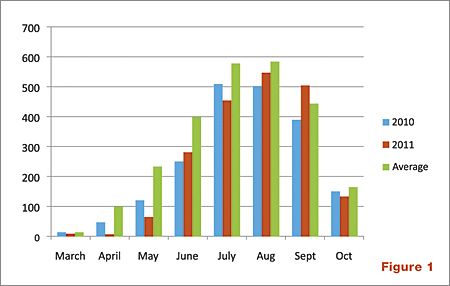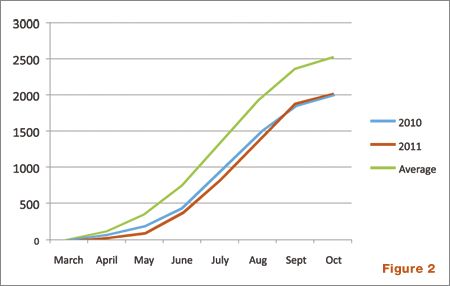A Harvest to Remember


By Jessica Cortell
Harvest is done, and it is time for the holidays and reflection. This was certainly one of the coolest vintages and latest harvests on record. The word is out that this was the “miracle” vintage.
Yield in 2011 was the opposite of 2010, when yields were naturally low due to poor fruit-set, resulting in fewer berries per cluster. Last year’s small crop helped the vines ripen the fruit. This year, sunny weather brought good fruit-set and large compact clusters. Average Oregon Pinot Noir clusters are usually around 100 grams (0.22 lbs); this year there were plenty of half-pound clusters — I weighed one unusually large cluster, and it was almost a full pound.
The large crop presented challenges in determining how much fruit should be thinned because of the cool season. In some select vineyards, winemakers and growers opted for less than one cluster per shoot. Others went to one cluster, dropping any green clusters that were behind during fruit coloring. Even so, many growers still came out 15 percent or more above what they expected. And for whatever reason, the birds did not “help” reduce the yields as they did in 2010.
Besides slowing the ripening process, these large compact clusters had the potential to present another challenge in being highly prone to botrytis (rot). There would only need to be conducive weather conditions during ripening to start the disease.
And then the rain came — just what we didn’t need! The showers started in early October and not for only a day or two. Just as I had suspected: The steady moisture encouraged botrytis infections. Some sprayed and still had problems, while others did minimal sprays and had few problems; this is because cluster size and compactness have the greatest impact on susceptibility to rot.
Other factors contributed to high botrytis incidence, including bad timing of the pre-bunch closure spray — once the clusters close, spray can’t penetrate the bunch — as well as poor spray coverage, lack of air flow, low elevation sites, early rains and high vine vigor versus nitrogen.
One winemaker mentioned that vineyards pulling leaves on both sides of the fruit had much less botrytis than those that only pulled leaves on one side. Pulling leaves early, and on both sides, definitely had benefits in reduced disease pressure and improved fruit color and flavors.
Luckily, we made it through the rainy period and were blessed with three weeks of dry weather through the end of October and into the start of November. My thoughts turned from dismay to optimism walking through the vineyards. The flavors really evolved in the last 7 to 10 days before harvest.
If you recall in the June OWP, I wrote, “Ultimately, the harvest date comes down primarily to when we reach bloom.” The last three years, we picked around 104 days after bloom. If we take July 6 as our 50-percent bloom date and consider when we harvested this year, we picked 119 days after bloom, based on a Nov. 2 harvest date. Did we catch up? No, we just were lucky.
In comparing the heat units from 2010, 2011 and the average (back to 1985) from the Northwest Viticulture Center (Figure 1), April and May were substantially lower in 2011 than 2010 on the average. July was warmer in 2010, but August and September were warmer in 2011. September was so hot for the first two weeks in 2011 that it was warmer than the average. October was cooler than normal. Total heat units were higher in 2011 than 2010 but only by 17 units (2005 versus 1988). Both vintages were unusually cool compared to the long-term average is 2,520 heat units (Figure 2).
The fact that we were able to let the fruit hang 15 days longer than in 2010 results in fantastic flavors and better pH and acid balance in many vineyards. In general, sugars were low; however, this level can be adjusted in the winery. Flavors need to come from the vineyard.
Unfortunately, I saw some vineyards harvested before they were ready. Those who held on patiently will be richly rewarded in the wines.
Jessica Cortell received a M.S. degree in horticulture and a Ph. D in food science and technology from OSU. She owns Vitis Terra Vineyard Services and teaches at the Northwest Viticulture Center in Salem.










